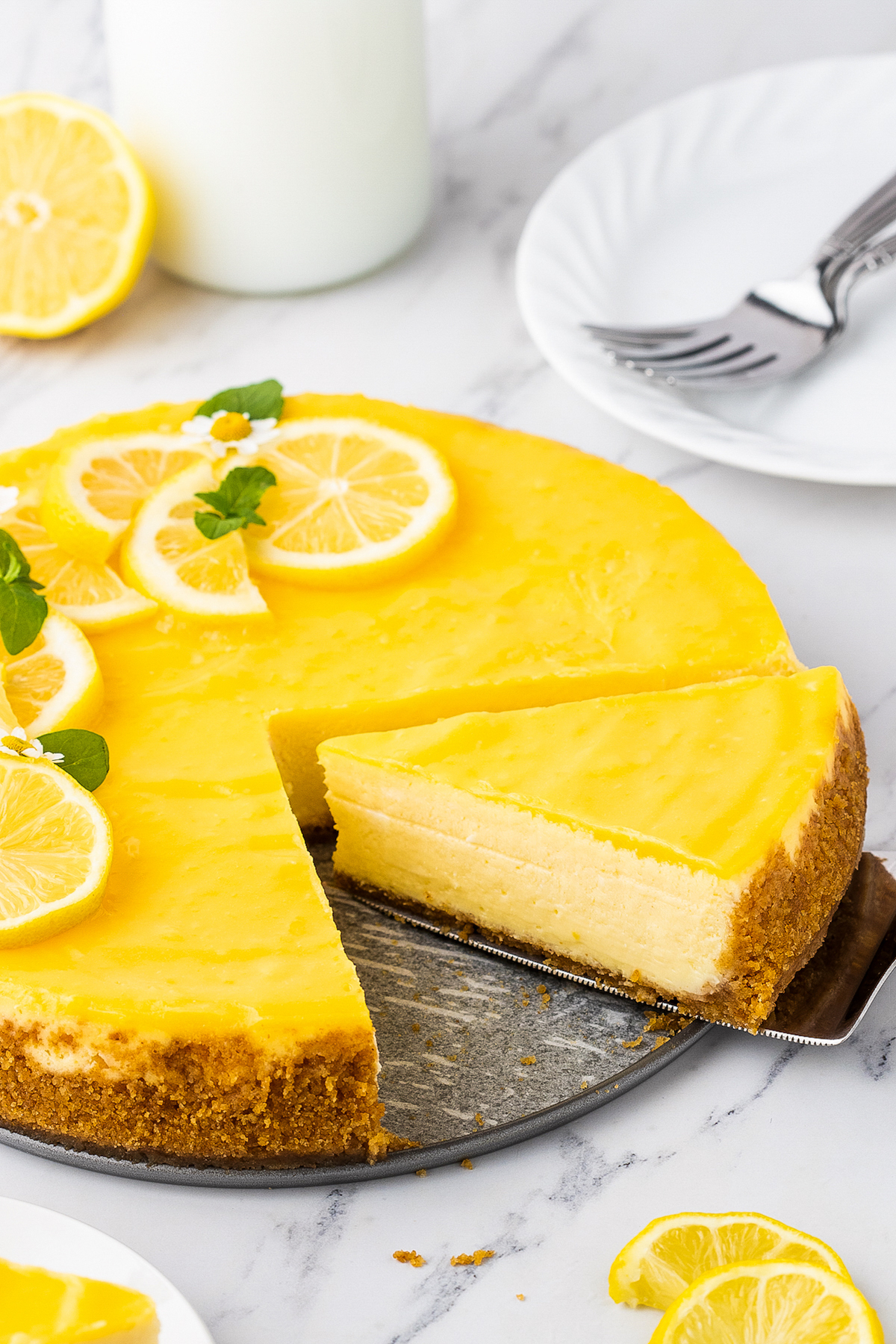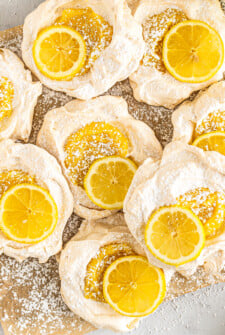This lusciously creamy and tangy lemon cheesecake recipe is perfectly balanced with a crunchy graham cracker crust. Topped with a zesty lemon curd, it satisfies your sweet tooth with each refreshing bite!

Why I Love This Lemon Cheesecake Recipe
This lemon cheesecake recipe is zesty, creamy, and oh so refreshing. Just like my easy lemon bars recipe, it’s perfect to treat yourself to during the warm summer months. There’s something about this luscious, yet light dessert that is supremely addictive and always has me coming back for more. Here’s why I make this lemon curd cheesecake year-round:
- Bright and Flavorful: This super creamy cheesecake has a sweet and tangy lemon curd topping that is sure to wake up your tastebuds!
- Classic Crust: The graham cracker crust provides the perfect contrasting texture to the creamy filling of this lemon cheesecake.
- Refreshing: This rich yet refreshing dessert gets its flavors from vanilla, zesty lemon, and sweet cream cheese. It’s light enough for a hot summer day, but fancy enough for the holidays!
- Great For A Party: Cheesecakes are the perfect make ahead dessert as they are better the next day. This cheesecake also travels easily, just pop it into a cooler with a few ice packs!
Love making cheesecakes? Try my favorite coconut cheesecake, fall themed pumpkin cheesecake or fruity banana pudding cheesecake!

Key Ingredients
Below you will find helpful notes for key ingredients used to make this recipe for lemon cheesecake. Scroll down to the recipe card below for the full ingredient list and exact amounts!
- Graham Cracker Crust: This homemade crust is made with graham crackers and melted butter.
- Homemade Lemon Curd: You can use store bought lemon curd if you don’t have time!
- Cream Cheese: Use full fat cream cheese for best results.
- Lemon Zest: Use a microplane zester to grate the outside peel of the lemon. Be sure to only grate the yellow skin, not the bitter white pith below.
- Lemon Juice: Freshly squeezed lemon juice will add even more lemon flavor!
- Eggs: Allow them to come to room temperature before starting.
- Heavy Cream: Heavy cream helps give this cheesecake its deliciously creamy texture. I don’t recommend swapping it with anything else.

How To Make Lemon Cheesecake
While it might seem time consuming, I promise it’s an easy process! Below is a quick recipe overview, but please scroll to the recipe card at the bottom of this post for full instructions and to watch the step-by-step video.


- Prepare: Prepare the graham cracker crust in a 9-inch springform pan and the lemon curd.
- Filling: Beat the cream cheese, granulated sugar, and lemon zest until smooth and creamy. Add the vanilla extract and lemon juice.
- Add Eggs: Add the eggs one at a time, mixing well each time. Slowly add the heavy cream, until completely combined.


- Water Bath: Pour the cheesecake filling over the prepared crust. Place the cake pan into a large shallow pan. Fill the larger pan with hot water, until it comes halfway up the sides of the springform pan.
- Bake: Bake cheesecake for about 75 minutes, until the sides start to puff and the center is only slightly jiggly.
- Cool: Let the cheesecake cool at room temperature for one hour.
- Fridge: Spread lemon curd in an even layer on top of the cheesecake. Refrigerate for at least 5 hours.
- Serve: Garnish with fresh lemon slices, if desired. Slice and enjoy!
Want to save this recipe?

Chef’s Tips & Variations
- Room Temp: Allow the cream cheese and eggs to come to room temperature. Cold cream cheese can be hard to beat and mix, creating a lumpy cheesecake.
- Do Not Over Mix: If you get too much air into your cheesecake batter, the top can crack when baking. If it does crack, don’t worry! The lemon curd will hide any cracks!
- Boost the Flavor: Try adding vanilla bean paste for even more vanilla flavor.
- Cookie Crust: Try swapping out the graham cracker for Biscoff cookies, toss them in the food processor to create cookie crumbs. This spiced cookie flavor goes great with the tangy lemon!
- Gluten Free: A gluten free graham cracker crumbs work just as well as traditional.
- Cooling the Cheesecake: This is the hardest part! Be sure to let the cheesecake cool properly, according to the recipe instructions. If you try to serve it too soon, it won’t be set.


Lemon Cheesecake
Ingredients
- 1 prepared graham cracker crust
- 1 batch lemon curd, or store-bought lemon curd
Lemon Cheesecake Filling
- 24 oz (3 blocks) cream cheese, softened at room temperature
- 1 ¼ cups granulated sugar
- 1 tablespoon lemon zest
- 2 teaspoons vanilla extract
- ¼ cup freshly squeezed lemon juice
- 4 large eggs
- ½ cup heavy cream
Want to save this recipe?
Instructions
- Graham Cracker Crust: Prepare crust according to recipe directions in a 9-inch springform pan lined with a parchment paper circle. Bake for 10 minutes in a 325°F oven. Remove from the oven and allow to cool while making the filling.
- Lemon Cheesecake Filing: In a large mixing bowl with a hand mixer, beat the cream cheese, granulated sugar, and lemon zest until smooth and creamy. Add the vanilla extract and lemon juice, and mix until combined.
- Add the eggs 2 at a time, mixing until well combined. Slowly add the heavy cream, while mixing on low speed, until completely combined.
- Add a double layer of aluminum foil around the cheesecake pan to stop water from leaking in when placed in the water bath.
- Pour the cheesecake batter over the crust in the springform pan. Place the cake pan into a large shallow pan. Create a water bath by filling the larger pan with hot water until it comes halfway up the sides of the springform pan.
- Bake cheesecake until the sides start to puff, the center is slightly jiggly, and the surface is no longer shiny (about 75 minutes to 85 minutes).
- Allow the cheesecake to cool at room temperature for 1 hour. Spread lemon curd in an even layer on top of the cheesecake.
- Refrigerate cheesecake for at least 5 hours, or overnight, before serving.
⭐️ Tried this recipe? Leave a comment and rating! It only takes a minute and helps support our family-run blog. ❤️
Notes
Nutrition
Categories:
More of the Best Lemon Recipes
Post may contain affiliate links. Read my disclosure policy.













